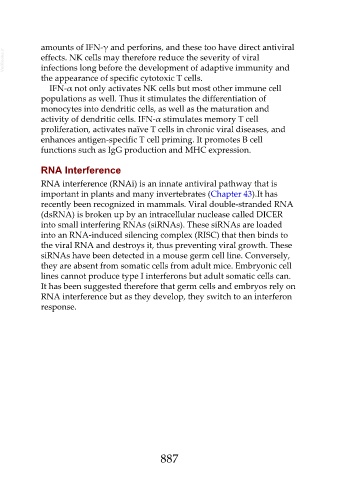Page 887 - Veterinary Immunology, 10th Edition
P. 887
amounts of IFN-γ and perforins, and these too have direct antiviral
VetBooks.ir effects. NK cells may therefore reduce the severity of viral
infections long before the development of adaptive immunity and
the appearance of specific cytotoxic T cells.
IFN-α not only activates NK cells but most other immune cell
populations as well. Thus it stimulates the differentiation of
monocytes into dendritic cells, as well as the maturation and
activity of dendritic cells. IFN-α stimulates memory T cell
proliferation, activates naïve T cells in chronic viral diseases, and
enhances antigen-specific T cell priming. It promotes B cell
functions such as IgG production and MHC expression.
RNA Interference
RNA interference (RNAi) is an innate antiviral pathway that is
important in plants and many invertebrates (Chapter 43).It has
recently been recognized in mammals. Viral double-stranded RNA
(dsRNA) is broken up by an intracellular nuclease called DICER
into small interfering RNAs (siRNAs). These siRNAs are loaded
into an RNA-induced silencing complex (RISC) that then binds to
the viral RNA and destroys it, thus preventing viral growth. These
siRNAs have been detected in a mouse germ cell line. Conversely,
they are absent from somatic cells from adult mice. Embryonic cell
lines cannot produce type I interferons but adult somatic cells can.
It has been suggested therefore that germ cells and embryos rely on
RNA interference but as they develop, they switch to an interferon
response.
887

